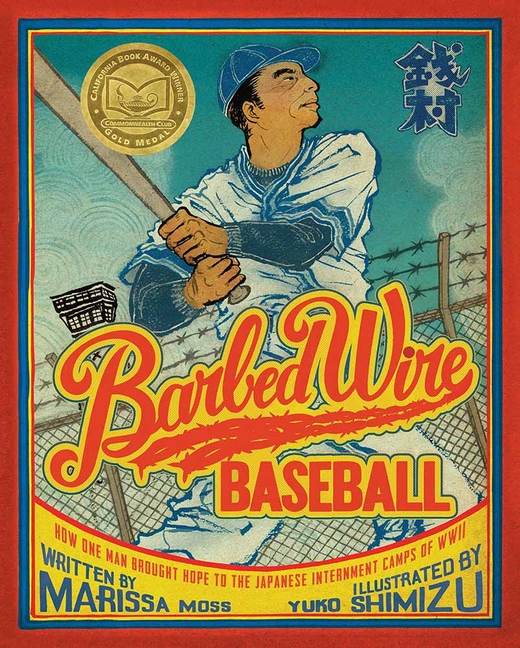Barbed Wire Baseball: How One Man Brought Hope to the Japanese Internment Camps of WWII
by Marissa Moss (Author) Yuko Shimizu (Illustrator)

As a boy, Kenichi "Zeni" Zenimura dreams of playing professional baseball, but everyone tells him he is too small. Yet he grows up to be a successful player, playing with Babe Ruth and Lou Gehrig! When the Japanese attack Pearl Harbor in 1941, Zeni and his family are sent to one of ten internment camps where more than 110,000 people of Japanese ancestry are imprisoned without trials. Zeni brings the game of baseball to the camp, along with a sense of hope.
This true story, set in a Japanese internment camp during World War II, introduces children to a little-discussed part of American history through Marissa Moss's rich text and Yuko Shimizu's beautiful illustrations. The book includes author and illustrator notes, archival photographs, and a bibliography.
 Locate at a Library Near You
Locate at a Library Near You WorldCat is the world's largest library catalog, helping you find library materials online.
Find books about:
Publishers Weekly
In her picture book debut, artist Shimizu finely crafts pen-and-ink illustrations with a calligraphy brush to help portray a true story of resilience during WWII. Born in Japan, Kenichi Zenimura, nicknamed Zeni, grows up in Hawaii and California loving and playing baseball. When WWII sees him, his wife, and teenage sons sent to an Arizona internment camp, Zeni "felt as if he were shrinking into a tiny hard ball." The bulk of Moss's (Nurse, Soldier, Spy) descriptive narrative centers on Zeni's efforts to build a baseball diamond at the camp. Thick brush lines create heavy textures in the digitally colored pictures, giving some the appearance of woodcut prints. All of the scenes occupy full spreads, echoing the expansive nature of Zeni's plan: unwilling to settle for a dusty dirt field, he irrigates it and grows grass; benches are made from wood scavenged under dark of night, and uniforms sewn from potato sacks. This triumphant story of how the father of Japanese-American baseball brightened the dark days of war concludes with an afterword, b&w photos, and notes from both author and illustrator. Ages 6-10. Author's agent: Alyssa Eisner Henkin, Trident Media Group. (Apr.)
Copyright 2013 Publishers Weekly, LLC Used with permission.School Library Journal
Gr 3-5--Focusing on her subject's strength of character and love of baseball, Moss introduces readers to Kenichi Zenimura (1900-'68). At barely five feet tall, Zeni was hardly a natural athlete; nonetheless, he developed great prowess as a player and coach. Before World War II, he played exhibition games alongside Babe Ruth and Lou Gehrig, and toured Japan, where he was born. His family moved to Hawaii when he was a child and later to Fresno, California. When war broke out, Zenimura, his wife, and teenage sons were sent to the Gila River internment camp in Arizona. In the barren desert environment, Zeni determined to build a baseball field and rallied others to his cause. Shimizu's artwork, created with Japanese calligraphy brush and ink on paper and Adobe Photoshop, depicts Zeni hoeing and pulling weeds in the hot sun. He made a field with real grass; a fence of castor beans; and, in an ironic twist, bleachers with wood scrounged from the barbed-wire fence posts surrounding the camp. In an afterword, Moss notes that Zenimura won posthumous induction into Japan's Shrine of the Eternals, the equivalent of baseball's Hall of Fame in Cooperstown. Text and illustrations mesh to create an admiring portrait of an exemplary individual who rose above his challenges and inspired others. Pair this picture book with Ken Mochizuki's Baseball Saved Us (Lee & Low, 1995) for an excellent read-aloud, or use it to introduce Kathryn Fitzmaurice's chapter book A Diamond in the Desert (Viking, 2012). Together these books offer insightful portrayals of the Japanese American internment experience.--Marilyn Taniguchi, Beverly Hills Public Library, CA
Copyright 2013 School Library Journal, LLC Used with permission.Review quotes
JNF054010 - Juvenile Nonfiction | Sports & Recreation | Baseball & Softball
JNF018020 - Juvenile Nonfiction | People & Places | United States - Asian American
United States
20th century
World War, 1939-1945
Baseball
Japanese Americans
Evacuation and relocation, 1942-1945






